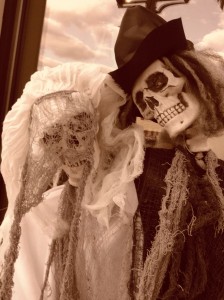
I can’t be the only mother who secretly detests Halloween. I hate the costume planning that inserts itself into a busy harvest season, requiring either absurd amounts of money or the investment of astronomical commitments of time at a sewing machine for one evening of candy-drugged over-stimulation. It inevitably results in crazed children raging between tears of artificial coloring-induced mania and fits of hysterical energy surges from high fructose corn syrup and sugar. This night of genuine horror is then followed by the sticky days of the ensuing period, where my little monsters fixate on the candy hoard, attempting to wheedle, sneak and negotiate for incessant sugar hits from the stash. Their slowed access to the drugs merely drags out the torture, stimulating a week-long addictive period ,where they vacillate between the highs and lows of their sugar hits. I am put in a position of either kill joy or liar as I attempt to control their access, and then, eventually, make it all disappear while they aren’t looking.

We have tried distracting them with Halloween parties, where wholesome treats were put before my children and their friends as an alternative to trick-or-treating. But then, in addition to all the costume preparations, we were faced with the task of interrupting our regular labors to add in new ones: Dust away the real cobwebs and replace them with fake ones; come up with grain-free, dairy-free, locally-based, earth-friendly menu choices (thankfully potato vodka is a local grain-free food around these parts); host the party; and finally, watch our kids moan with despair as each of their friends leave to go trick or treating, while we stay home with a pile of dishes and party detritus to wash up. I fantasized about simply removing the holiday from the calendar, but our culture simply makes that impossible.
Instead, a few years ago, I began investigating the historical roots of the holiday, hoping to find some other palatable tradition that would offer our family a celebration without all the torture. Investigating my own heritage, I read up on the ancient Druid practices for the festival for Samhain, who was their Lord of the Dead. The eve of that festival, the earliest Halloween celebrations, were marked by fire rites, where animals, prisoners of war and criminals were burned alive in baskets as part of a method for portending the future. And I thought Tootsie Rolls were bad.

The Druids were eventually invaded by the Romans, who had their own festivals of the dead, such as Feralia. This was a February festival where offerings were made to the ancestors, and an old woman would put some beans in her mouth, smear a fish head with pitch and roast it over a fire. Hmm. That might be a hard sell for the girls. Anyhow, according to my reading, Feralia eventually migrated over to October and November, to merge with the Druid Samhain, as did the Roman Feast to honor the goddess of the orchards, Pomona. Burning prisoners and animals was replaced by bobbing for apples and leaving gifts for the ancestors. A nice improvement. A few hundred years later, the rise of Christianity put the church’s stamp on the holiday, by adding in All Saints Day, in memory of Christian martyrs. While this holiday was originally celebrated in May, it too migrated over to early November.
Three spiritual traditions all seemed to concur that there is something about this time of year that deserves special attention. And while I would love to be done with the candy, the costumes and the trick or treating, and I certainly have no desire to burn ritual sacrifices, I do believe there is magic in this time. We are midway between the autumnal equinox and the winter solstice. The days are growing perceptively darker. The leaves are withered and decaying on the ground. The animals are being slaughtered for winter. The garden plants are pulled from the ground, and the soil turned under. The world around us is in the process of dying and returning to the earth.
And in that death process, I see the need to celebrate. Our modern consumer culture reveres life and eschews death. Factory farming systems help people to disassociate the slaughter of animals from the packaged food in grocery stores. We are daily bombarded with advertisements, books, and news stories for anti-aging creams, anti-aging drugs, anti-aging diets, anti-aging exercise plans. And too often, the sick, the aging and the dying are removed from their homes and their families, sequestered away from sight, so that our daily lives permit us to see only the living and the healthy.
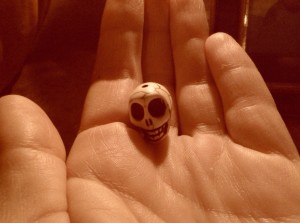
But death is the other half of life. There is no sustenance that we can take into our bodies that does not require death. There is no way to sustain balance on our earth without death. The life and death of each ancestor has lead to each spirit that walks this earth at this moment, including myself, and all those whom I love dearly. The death of the livestock and the gardens and the flowers and the grass mean rest. The return of darkness means reprieve.
Thus, celebrating the last few days of October and these first few days of November is critically important as I help my children to envision a sustainable future. Sustainability requires death. It means accepting our mortality without fear. It requires making friends with death.
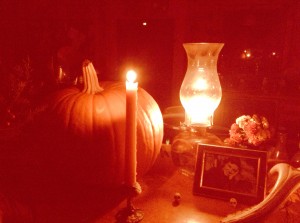
And while I still don’t think M&Ms are a suitable way to celebrate, I am willing to let that go on October 31st. Because in exchange, on a different night, our family has our own quiet, private, celebration of death. We spread pictures of deceased loved ones across our kitchen counter. We decorate further with skulls, skeletons and bones, all the beautiful mortal remains we can think of. We light candles for the animals who have been slaughtered that sustain our lives and our livelihood. We light candles for any loved ones we have lost over the year. We light candles in honor of the ancestors in each of our family branches.
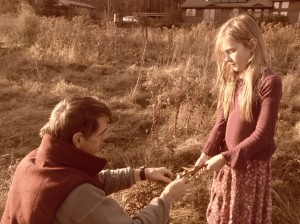
Bob and the girls harvest asparagus fronds to make a crone. We parade her to the garden, where we pour over the soil a glass of cider pressed from our wild apples. We bring the crone inside and seat her at the head of our table, where she reigns supreme over our dinner. We eat a simple stew, made from our harvest, leaving a bowl for the crone and our ancestors, and offering helpings to our canine companions. We talk about who went before us, we give prayers of thanks for their lives and the energy they brought to this world. We privately sit before their photos and talk to them. We give thanks for the food, for each other, and for the darkness and death that allows us our rest and renewal. And in this night of prayer, feasting and ritual, we teach our children that death, too, is worthy of celebration. We help them to confront their fears of mortality, just as we confront our own.
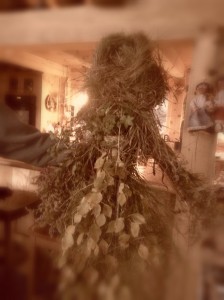
I still hate trick or treating. But I do allow it, as I have learned that I cannot always ignore all aspects of my culture that I do not like. But over the years, as our family has drawn on history to build a new tradition to celebrate the full circle of life, including the macabre, I find I am more at ease with a night of trick or treating. We have our own quiet celebration of death, and all the real cobwebs in my house can stay in place….until my mother-in-law comes for Thanksgiving…

This essay was written by Shannon Hayes, whose blog, RadicalHomemakers.com, is supported by the sale of her books, farm products and handcrafts. If you like the writing and want to support this type of creative work, please consider visiting the blog’s farm and book store.
To view Ula’s Greeting Cards and support Saoirse and Ula’s (Shannon and Bob’s kids) entrepreneurial ventures, click here.
Feel free to click on any of the links below to learn about Shannon’s other book titles:


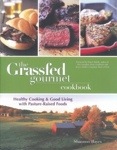
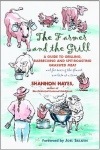
This is fabulous, Shannon! I feel the much the same way. My husband is from Mexico and we celebrate Dia de los Muertos along with Halloween (technically, Nov 1 and 2). We set up a table in the living room and cover it with photos of our loved ones who have passed (both human and animal) and other remembrances of them. We also put out skeletons, candy skulls, oranges, flowers, candles, and tequila. It’s a wonderful opportunity for our three kids to remember the loved ones they knew and to learn about the ones who passed before they were born. I also believe our culture has an unhealthy fear of death and I’m trying to remedy that in my own home. I love that your family also remembers the animals that were slaughtered for meat in the past year. I did not think to include them in our celebration but I certainly will next year!
I like your family’s “new” rituals and celebration of the season and death- very creative. I am caring for parents who are nearing death and am determined to let them stay in their home, and have seen it can be a special time when they are almost entering the other world at times. I may borrow some of your ideas to practice with my husband and daughter and her children (my very Catholic parents probably wouldn’t think them so wonderful!) But the more at peace we are with death the better ours lives seem to be. Also I loved hearing your true feelings about the Halloween candy- I became so good at “disappearing” candy I would have made a Columbian drug lord proud.
Well said. We are indeed free to embrace our culture as it is, but we are also free to shy away from it as well. Our future and the future of our children depend on our ability to do what is right and act responsibly, even if it’s not what “everyone else” is doing. The act of remembering our ancestors and celebrating their lives, while acknowledging the wisdom that comes from past generations is a beautiful thing to share with our children. What better way to pave a new future. Peace to you and your family : )
I like everything about the season, including the trick or treating. It’s the only time of year people come out on their porches or get in groups and walk around. In the suburbs, it appears we live on a movie set: vacant-looking houses with cars that pull into garages and disappear. People only emerge when 1.) there’s a power outage or 2.) Halloween. I don’t fret about the candy. It’s the only time of year my kids get unlimited access to such treats. I love to see how they willingly keep walking, come dark or damp, to get to “one more house.” Then they pour out their loot and begin scheming how to trade for something else. My daughter was THRILLED to get two Peppermint Patties. This was 20 cents worth of candy, but she reacted like it was a lottery win. We have talked about where this ritual comes from — offering treats to the dead; disguising oneself from evil spirits — but it has become a chance to be someone/something else for a day. Day of the Dead/Samhain/Halloween — yes, yes, yes!
Shannon, being raised in the Catholic Faith I have always been well aware of All Souls and All Saints, and gladly watch as my own two boys remember those that have left us and the saints/spirits that are all around us…Christian too, has an appreciation for this time of year when we pause and remember all those that we have had to let go. Thank you for writing so eloquently about this… I anxiously wait for the Halloween when my boys are old enough not to bother with it anymore….